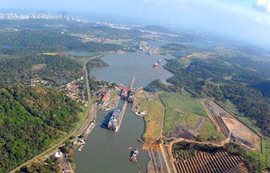
Panama’s eponymous canal is not the world’s longest, deepest, nor widest man-made waterway, but it is an enduring testimony of the triumph of man’s ingenuity as well as the standard-setter for global shipping today.
Interest in cleaving a link between the Atlantic and Pacific oceans dates back to sixteenth century Spain, when Vasco de Balboa first recognized the potential of the slender land bridge of Panama. With the patronage of Emperor Charles V, surveyors began intensive engineering studies but later abandoned them as impossible to execute.
Three hundred years later, hard on the heels of the triumphant success of the Suez Canal, a French company led by Ferdinand de Lesseps broke ground in Panama, only to have their attempts to build the canal without locks end in disaster, financial scandal, and the tragic deaths of thousands of workers to accidents and tropical diseases.
The rising economic and military power of the hemisphere, the United States now entered the arena. Abandoning plans to construct a canal in Nicaragua, President Theodore Roosevelt threw his political might behind Panama’s revolutionaries and later their independent provisional government in exchange for the rights to construct and control the Panama Canal.
Work commenced in 1903, which would eventually boast twelve pairs of locks and hydro-powered “mules” which power ships through the canal’s 51 miles, from Atlantic to Pacific. Opened in 1914, it was a tangible symbol of the economic might and prowess of the new world at a time when the old world was embarking on a devastating world war.
Today, the Panama Canal is one of the world’s most heavily-trafficked waterways with between twelve and fifteen thousand ships crossing each year and is considered one of the world’s modern wonders. Plans are underway to widen the canal considerably to accommodate “post-Panamax” cargo and cruise line behemoths too large to fit through today’s locks. The $5.25 billion expansion is nearly complete and expected to open with great fanfare in April 2016.
The Panama Canal is not without its quirks and foibles. Despite the east-west itinerary, the canal actually runs north-south, and thanks to the inverted “S” shape of the canal, the sun always rises over the Pacific and sets over the Atlantic. It is also the only canal to lend itself so handily to a palindrome, as the title of this post attests!
Alexander+Roberts include the Panama Canal on a number of South American itineraries, including
The Complete Panama Canal for an intimate and elegant travel experience through this legendary waterway.